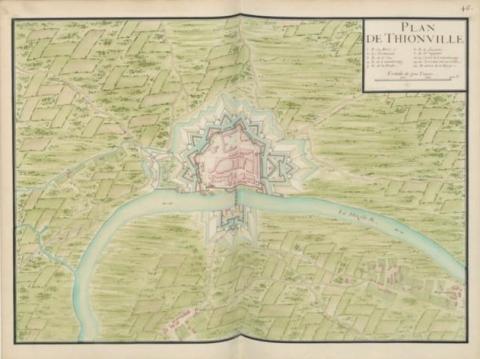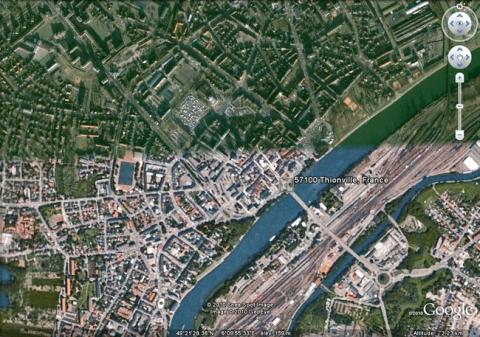Thionville
History and description
Situated in a bend of the Moselle, Thionville appeared for the first time in a Carolingian chartulary record of Pépin le Bref (Pippin the Short) in 753. It is a district with a royal palace. This palace disappeared at the end of the reign of the French Carolingians and was replaced by a seigneurial tower surrounded by a moat, equipped with a cistern and storage magazines: the tour des Puces which dates back to the 11th century. An earth ramparts would have probably surrounded the town in this period. It was not until the charter of the count de Luxembourg from 1239 that it was replaced by a urban wall constructed in 1268. The tower became the rectangular keep of a castle, and served as an inner fortified structure. The urban wall of the town incorporated two gates, namely of Metz and Luxembourg. The duke of Burgundy Philippe le Bon (Philip the Good) conquered the town in 1443. The fortifications accommodated a restoration and the water was used more systematically for defence. The stream of the Fench was used to flood the moat, while the defences of the left bank of the Moselle were reliant on the river. The first adaptations made to accommodate metallic artillery were ordered by Charles Quint in 1542. Artillery ramparts were constructed on the ramparts, the battlements of which were removed and turreted, wider platforms were added to the towers. These initial modifications, completed in 1546, were not sufficient to prevent a first French conquest by the armies of Henri II in 1558. Philippe II of Spain ordered in 1559 the transformation of Thionville into a genuine bastioned fortification, based on advice from a resident, Nicolas de Mamerus, in 1561. The project was drawn up by Jacques Van Noyen in 1568: the town was expanded and equipped with a hexagonal urban wall with six arrow-headed angled bastions and a demi-bastion on the right flanks in the middle of the curtain wall on the side facing the Moselle. The construction took place from 1596 to 1607. The Thirty Years war prompted the Spanish to complete these defences with the construction of four ravelins and a hornwork to the north-east, along the Moselle. These works were built in 1630-1635. Besieged in 1643 by the Prince of Condé, Thionville was conquered by the France this year, conquest certified by the treaty of the Pyrenees from 1659.Vauban intervened in Thionville between 1673 and 1693. He reorganised the defences of the town on the left bank, adding tenailles in front of the curtain walls and counterguards in front of the bastions. In 1695, he improved the defences still further with the addition of a second glacis and six advanced lunettes. An inner fortified structure flanked with two lunettes was added to the Spanish hornwork. Vauban was the first engineer to extend the fortifications of Thionville on the right bank of the Moselle. To do so, he had the first stone bridge constructed on the river and added a hornwork flanked with two lunettes on the other side. The Swiss captain Rodolphe Salzgueber, member of the foreign guards, supervised the construction on-site. In 1677, Vauban advocated the enlargement of the hornwork built in 1673, but this project remained on the drawing board. Another project, consisting of the creation of an entrenched camp on the right bank and dating from 1705, also remained unfinished.
The 18th century saw significant modifications to the aspect of the stronghold. In 1725, the engineers Tardif and Duportal partially created the project of the entrenched camp by replacing the hornwork of the right bank, created by Vauban. This construction was a crownwork, called double couronne de la Moselle (Double crown of the Moselle) was built. It included two bastions with straight flanks, two demi-bastions, three ravelins and a covered way to parade grounds for those returning. The construction of this work was completed between 1727 and 1730. During the next five years, the creations of these two engineers were visible on the urban wall of the old town on the left bank. They successively added counterguards and a new glacis in front of the ravelins and bastions, followed by a belt of eleven lunettes in front of these counterguards. The lunettes were linked to protruding sections of the counterguards by covered ways. This construction was completed in 1735. Ten years later, Louis de Cormontaigne (1696-1752) boosted the defences of Thionville still further. To do so, he constructed a new type of crownwork, the crowned (known as Yutz) was on the right bank, ahead of the crownwork of 1727-1730. It included three bastions with straight flanks, two ravelins, two tenailles, dry moats and a covered way. To connect it to anterior works, the crown was extended towards the crownwork by two curtain walls and two bridge-locks which closed off a diversion of the Moselle, created in 1740 to prevent floods and use the water of the river for defending the location. These two bridges included the same equipment: first of all, a base comprising a bridge with archways equipped with grooves for the grilles which could be lowered in the event of floods and the river freezing up. Subsequently, a vaulted mezzanine floor linked the two buildings at three levels and was used to house mills and to store the wheat and the grain. The buildings were placed on either side of a central causeway. The grilles of the central arches of these two bridges had to be lowered down to the base of the canal in order to allow boats to pass. The urban planning was also incorporated in the projects of Cormontaigne. He installed a second parade ground at the centre of the crown, equipped with radio concentric streets. Two barracks were also constructed there, which housed two battalions of infantry and a cavalry major. He built new food stores, ovens and additional mills. The streets were paved, crowned and drained. Cormontaigne sets out standards concerning civilian ways which he wanted to see applied to the crown to expand the town: the number of storeys of houses would have to be limited, the courtyards and garden areas would have to be at the centre of islets and the roofs would have to be covered in roofing slate on the outside and normal tiles on the garden side. However, this planning did not come to fruition. Cormontaigne planned that with his modifications, Thionville would be able to accommodate a garrison of almost seven thousand men. Following his death in 1752, the engineer Pierre Filley improved the works of Cormontaigne, adding cavalries and firing slots to the Spanish bastions, the flanks of which were also straightened. He completed the bridge-locks, which had not had grilles applied in 1752 and improved the hydraulic system. He also advocated adding magazines to the town. Multiple defence works of the town on the left bank were created in stone during this period. These modifications commenced in 1777 but remained unfinished in 1789, since the grilles of the bridge-locks were not made. After 1871, the Germans constructed belts of seven peripheral forts in concrete around Thionville, between 1893 and 1900. Modernised up until 1914, they were not used during the First World War. However, two of them were modernised from 1926 and included in the Maginot Line.
Current state
The urban fortifications of Thionville were dismantled by the Germans from 1902 to 1903. Nothing has survived other than the medieval tour des Puces, two twin towers and two bastions of the urban wall of Charles Quint and Philippe II for the left bank. The side of the right bank, the Crowned of Yutz and its gate were preserved but spoiled when a new road link was constructed and with the construction of a working district in the Between-Two-Wars period. The German forts of the 19th century and the works of the Maginot Line still exist in the form of a memorial and are publicly accessible.
Thionville
Thionville
49° 21' 32" N, 6° 10' 9" E
Type
urban wall, hydraulic defence
Engineers
Jacques Van Noyen, Sébastien le Prestre de Vauban, Tardif, Jean-Jacques Duportal, Louis de Cormontaigne
Department
Meurthe-et-Moselle
Region
Grand Est
Bibliography
- BASTIAN (C.), Histoire des fortifications de Thionville et de leur extension au Pays des Trois Frontières, Thionville, s. d.
- CHIMELLO (S.) et GAUDINET (F.), Les Ponts-écluses de Thionville, Thionville, 2006.
- GABER, Lorraine, la route des fortifications, Metz, 1999.
- MARTIN (P.), La route des fortifications dans l’Est, Paris, 2007.

